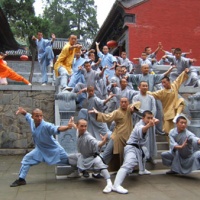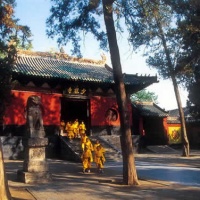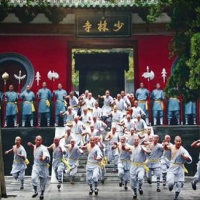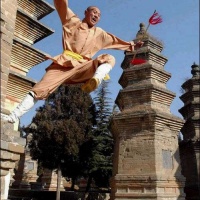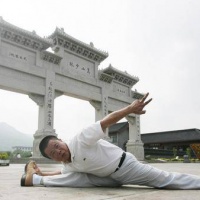- Home Page
- Fact Tours
Our sample tour itineraries of China and China travel packages are sorted by theme and available at competitive prices, you can browse what tours are right for you for your trip to China.
Popular China Tour Packages

Custom Tour Packages to China and Ask Our Experts for Free Enquiry !
- Coach Tours
- Destinations
Beijing, the capital of China. Its art treasures and universities have long made it a center of culture and art in China.
Beijing Top Attractions
Beijing City Tours
Best China Tours with Beijing
Shanghai, the cultural and economic center of East Asia. It renowned for its historical landmarks, the extensive and growing skyline.
Shanghai Top Attractions
Shanghai City Tours
Best China Tours with Shanghai
Xi'an, having held the position under several of the most important dynasties. It is the top destination to explore the facts of Chinese history.
Xi'an Top Attractions
Xi'an City Tours
Best China Tours with Xi'an
Huangshan boasts its culture, beautiful rivers, villages and mountains. It's home to 2 UNESCO World Heritage Sites and the Mecca of photographers.
Huangshan Top Attractions
Huangshan City Tours
Best China Tours with Huangshan
Sichuan is the cradle of the Shu culture, panda, mahjong, teahouse and spicy food. The province ranks first in China by number of UNESCO World Heritage Sites. It is called "the Heaven of Abundance".
Sichuan Top Attractions
Sichuan Tour Packages
Best China Tours with Sichuan
Yunnan, literally means the south of colorful clouds, due to its beautiful landscapes, mild climate and diverse ethnic cultures and traditions, is one of China's major tourist destinations.
Yunnan Top Attractions
Tibet, the nearest land to the sky, is known for its breathtaking landscape, splendid culture, art, buildings, and mysterious religions.
Tibet Top Attractions
Tibet Tour Packages
Best China Tours with Tibet
Explore the lost civilizations by riding a camel! Travel across the Gobi and the desert, and over the high mountains. Our Silk Road tours including different sections of the Silk Road in China.
Silk Road Top Attractions
Silk Road Tour Packages
Best China Tours with Silk Road
Guilin, an internationally-known historical and cultural city, has long been renowned for its unique karst scenery. Its vicinities are the paradise of hiking, caving, rafting, biking and countryside exploring.
Guilin Top Attractions
- China Facts
- China Hotels
- Travel Photos
Attractions
Shaolin Temple
There are two Shaolin Temples in China. One is called Northern Shaolin Temple and the other is Southern Shaolin Temple (in Putian City, Fujian Province). When the Chinese mention the Shaolin Temple, they commonly refer to the Northern Shaolin Temple for its longer history. The Shaolin Temple is a Chán Buddhist temple at Songshan Mountain in Dengfeng City (near Zhengzhou City, the capital city of Henan Province). Today, it is led byvenerable abbot Shi Yǒngxìn. Founded in the 5th century, the monastery is long famous for its association with Chinese martial arts and particularly with Shaolin Kung Fu, and it is the Mahayana Buddhist monastery perhaps best known to the Western world.
History & Story
In AD 495, when Bodhidharma, a Mahayana Buddhyist, left Sri Lanka for China in the 6th century and developed the Chán (Zen) Sect (a Chinese Buddhist school). At that time, Emperor Xiaowen of the Northern Wei Dynasty (AD 386-534) ordered the establishment of a magnificent Buddhist temple (Shaolin Temple) in honor of Bodhidharma, a knowledgeable monk who came from India to teach Buddhist scriptures to the Chinese. According to historical records, the famous Buddhist arrived in the city of Guangzhou in South China in 527, several years before going to Songshan Mountain. Instead of touting the Buddhist scriptures at the very beginning, Bodhidharma spent 9 years meditating about philosophical problems inside a cramped cave close to the top of the mountain. Facing a large rock at the end of the cave, which was seven meters long by 3 meters wide, Bodhidharma meditated for most of the day as he was so engrossed in Buddhist theories. Legend claims that sunlight burn an image on the surface of the rock in front of him. In order to commemorate a monk with such unparallel will power, people named the historical site Bodhiharma's Cave. In order to protect the cave from demolition, monks moved the valuable stone inside the temple and occasionally presented it with tributes, because the rock is one of the treasures of the Shaolin Temple. Another valuable legacy left by the famous founder of the Chinese Chán (Zen) Sect is martial arts. It is said that Bodhidharma was accustomed to doing exercises by imitating a tiger, monkey, scorpion and mantis during the intervals in his meditation. Over the original form of martial arts came into being. Due to the efforts of the original monks and those of later generations, the art was constantly improved and formalized. Practicing kungfu has become commonplace among monks since then. He gathered together a large number of followers to whom he taught the doctrines of Chan Buddhism. Since that time, Shaolin Temple has become the ancestral court of Chán (Zen) Sect of Chinese Buddhism.
At that time, the elderly disciple of Bada, Seng Chou and Hui Guang, were skilful in martial arts, and capable of kicking a shuttlecock back and forth 50 times on a raised platform by the side of a wall, and “walking on the side of the wall and jumping upon roof beams. They started the tradition of martial arts at Shaolin Temple. After his arrival, Dharma advocated sitting absolutely still in meditation by facing the wall for a long time. In order to exercise the bodies and strengthen the nerves of the monks as well as for self-defence, the tendency of practicing martial arts became increasingly popular. At the end of the Sui Dynasty )581-618), and in the early years of the Tang Dyansty (618-907), a general of the Sui Dynasty by the name of Wang Shichong ordered his nephew Wang Renze to occupy a strategic terrain in the vicinity of Shaolin Temple and resisted the attacked of the Tang army. Emperor Gaozu of the Tang Dynasty sent his son Li Shimin, Prince Qin, to attack Wang Renze in order to unite the whole country, Li Shimin (599-649, reigned 626-649) led his troops to capture the city of Luoyang, which was controlled by the powerful warlord Wang Shichong. Unfortunately, Li’s troops were defeated and the warlord’s soldiers caught the prince. The city of Luoyang was only about 50km from the Shaolin Temple so the monks heard the bad news quite soon. Out of deep love towards the wise prince, the abbot decided to send 13 monks with superb martial arts to save him from jail. Disguised as ordinary folks, the monks entered the prison and succeeded in rescuing the incarcerated prince. With the help of 500 monks, the prince’s troops conquered the enemy days later. After Li Shimin ascended the throne years later, he returned to the temple in a bid to show his gratitude. The emperor praised the Shaolin Temple, saying it was the top temple in the country. In addition, he made the 13 monks generals, but did not succeed for quite some time.
In the time of danger, Shaolin monks Tanzong and Zhicao, dissatisfied with the oppression by Wang Renze, led 13 valiant monks to break into the barracks of the Sui army. They captured Wang Renze, led 13 valiant monks to break into the barracks of the Sui army. They captured Wang Renze and went over to Li Shimin, the second emperor of the Tang Dynasty. Taking this opportunity, the Tang army overwhelmed the army of Wang Shichoang at one stroke. This is the well known story of 13 Shaolin monks rescuing Prince Qin. Afterwards, the fam of the martial monks of Shaolin Temple was spread far and wide. The martial arts of Shaolin Temple has developed day by day and attained high degree of proficiency through tempering during the Five Dynasties and the Song, Yuan, Ming, and Qing dynasties.
A perfect tour for learning more facts about Chinese Kung Fu and the Shaolin Temple >> 12-Day China Heritage Tour
Shaolin Martial Arts
The martial arts of Shoalin (aka Shaolin Kungfu) today include several hundred varities, such as Chinese boxing, broadswords, spear, sword, rod, qigong (a deep breathing exercises), qinggong (ligh skill), neigong (internal skill), tongzigong (boy skill), zhuanggong (skill on stakes), mashanggong (skill on horseback), and buxiagong (skill on foot). Every kind of skill is practiced to surpringly high attainments.
Shaolin boxing is characterized by “lifting up leg as light as feather, kicking as heavy as Taishan Mountain; appearing as delicate as cat and as fierce as tiger; proceeding like dragon, moving like lighting and roaring like thunder:” and the difficulty of distinguished attack from defense and constant change. There is also "figure boxing" which imitates the actions of birds, beasts, insects and fish and is designed to take the opponent by surprise.
In addition to 18 kinds of common weapons such as sword, spear, and lance, the weapons of Shaolin also include rare weapons as iron fan, iron pen, iron flute, Shaolin prick, hand helmet and spearhead, used to take the opponent by surprise too.
The internal qigong of Shaolin can cultivate the heart and nature, and the external qigong (hard qigong ) can help strengthen one’s health and self-defense. Iron-sand palm, breaking stones with the top of head, iron cloth shirt and steel belly are all types of hard qigong.
The Shoalin’s tongzigong, once mastered, can make every part of the body as soft as cotton, as light as a swallow and as hard as steel. Shaolin plum-blossom stakes, each over two meters high, are used for practicing skill on them. The skill of “heart-and mind stake” is a combination of breathing and force. The hollows on the ground by monks’ practicing skill.
Usually, the martial arts of Shaolin is kept secret and not to be passed on to outsiders. The practice of the skills is also not to be made public. Their genuine skill (kungfu ) is accormplished through 10 or scores of years of hard practice. Their skill is indeed marvelous; the monks walk rapidly atop glass; they walk on precipices like walking on flat ground; they sleep on stakes leisurely; they stand on the top of their heads on granite. They can break a brick with the head, cut a stone with the hand, pierce wood with the finger, resist a lance with the throat, hold a car with the teeth, lick fire with the tongue and hand themselves on roof beam with the jaw. They can also break a rock with a kick, draw a motorcycle with an arm. If you are a guest in Shaolin Temple, please be careful! The iron kettle for containing tea is over 50 kilograms in weight.
The Pagoda Forest
With a history of more than 1,000 years from the Tang dynsty (618-907) to the Qing dynasty (1644-1911), the Pagoda Forest in the Shaolin Temple has more than 230 survived till now. Despite the difficulty, the temple has been making active moves to safeguard its intellectual property rights. The forest is a treasure house for the study of the ancient Chinese brick structure and sculpture art.
Shaolin Contact Info
|
Shaolin Temple |
Abbot’s Room |
TEL:0086-0371-62749305 |
|
Temple Affairs Office |
TEL:0086-0371-62749305 | |
|
Shaolin Reception Hall |
TEL:0086-0371-62745166 | |
|
"Chan Dew” Journal |
Editorial Office |
TEL:0086-0371-65582653 |
|
Yi Jin Jing & Xi Sui Jing Research Society |
Master Yanwang |
TEL:0086-0371-62749616 |
|
Shaolin Intangible Assets Management Center |
|
TEL:0086-0371-65582651 |
|
Shaolin Temple Communications Office |
|
TEL:0086-0371-67300086 |
|
Shaolin Temple Website |
|
TEL:0086-0371-65582653 |
|
Shaolin Orphanage |
|
TEL:0086-0371-67300188 |
|
Shaolin Temple Culture Communication (Dengfeng).Co. Ltd |
TEL:0086-0371-67300188 | |
|
Shaolin Pharmacy Bureau |
TEL:0086-0371-62749123 | |
|
Shaolin Kungfu Monk Corps |
|
TEL:0086-0371-67300030 FAX:0086-0371-67300135 |
Questions & Comments
Home | About Us | Partnerships | Terms & Conditions | Privacy & Security | Payment Guide | Resource Links| Sitemap
Email: contact@chinafacttours.com, Tel: +86-773-3810160, Fax: (+86) 773-3810333
Copyright © 2008-2020 China Fact Tours. All rights reserved
![]()










